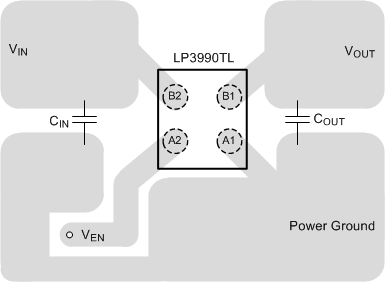SNVSA66A October 2014 – December 2015 LP3990-Q1
PRODUCTION DATA.
- 1 Features
- 2 Applications
- 3 Description
- 4 Revision History
- 5 Pin Configuration and Functions
- 6 Specifications
- 7 Detailed Description
- 8 Application and Implementation
- 9 Power Supply Recommendations
- 10Layout
- 11Device and Documentation Support
- 12Mechanical, Packaging, and Orderable Information
Package Options
Mechanical Data (Package|Pins)
- YZR|4
Thermal pad, mechanical data (Package|Pins)
Orderable Information
10 Layout
10.1 Layout Guidelines
The dynamic performance of the LP3990-Q1 is dependant on the layout of the PCB. PCB layout practices that are adequate for typical LDOs may degrade the load regulation, PSRR, noise, or transient performance of the LP3990-Q1.
Best performance is achieved by placing CIN and COUT on the same side of the PCB as the LP3990-Q1, and as close to the package as is practical. The ground connections for CIN and COUT must be back to the LP3990-Q1 ground pin using as wide, short copper traces as is practical.
Connections using long trace lengths, narrow trace widths, or connections through vias must be avoided. These add parasitic inductances and resistance that results in inferior performance especially during transient conditions.
A Ground Plane, either on the opposite side of a two-layer PCB, or embedded in a multi-layer PCB, is strongly recommended. This Ground Plane provides a circuit reference plane to assure accuracy.
10.2 Layout Example
 Figure 17. LP3990-Q1 DSBGA Layout
Figure 17. LP3990-Q1 DSBGA Layout
10.3 DSBGA Mounting
The DSBGA package requires specific mounting techniques, which are detailed in TI Application Note DSBGA Wafer Level Chip Scale Package (SNVA009).
For best results during assembly, alignment ordinals on the PC board may be used to facilitate placement of the DSBGA device.
10.4 DSBGA Light Sensitivity
Exposing the DSBGA device to direct light may affect the operation of the device. Light sources, such as halogen lamps, can affect electrical performance, if placed in close proximity to the device.
The wavelengths that have the most deterimental effect are reds and infra-reds, which means the fluorescent lighting used inside most buildings has little effect on performance.